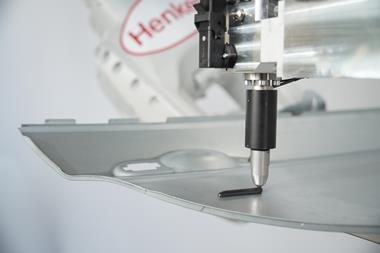Duplex coatings designed to prevent corrosion need to be measured with appropriate equipment, says Peter Neumaier, technical sales manager, Helmut Fischer

Corrosion-protective duplex coatings are frequently used in the automotive industry for pipes and wires in brake and fuel systems, plus other vulnerable areas. The coatings are composed of a 25-30μm zinc layer and a paint or plastic layer of 20-100μm. The thickness of these coatings is an important quality factor and a non-destructive measurement method is crucial for quality assurance as well as cost control.
There are four main types of industrial duplex coatings: Class 1: Hot-dip galvanised steel components with a zinc coating thicker than 80μm, distinctive zinc-iron diffusion zones and a paint coating with a typical thickness of more than 85μm. These are used primarily in the field of steel construction.
Class 2: Zinc thicknesses up to about 10μm, deposited galvanically or in a dip bath, and paint thicknesses of up to 15μm. These are found primarily in automotive vehicle body manufacturing.
Class 3: Zinc thicknesses of up to about 30μm and an organic coating of paint or plastic with thicknesses of typically less than 200μm. These often feature on automotive piping.
Class 4: A zinc-iron or zinc-nickel alloy layer and an organic layer. Due to the high cost of the zinc alloy coating, these are found primarily on automotive components with a significant risk of corrosion.
As these duplex systems are a combination of organic and metallic coatings, typical metrology techniques for multi-layer systems, such as X-Ray fluorescence (XRF) or coulometric methods, are ineffective because they are incapable of measuring the pure organic elements involved. The only economical, non-destructive and user-friendly procedures available are those which incorporate both the magnetic induction and the eddy current test methods.
Measuring Class 2 & 3 coatings
The Class 2 and 3 duplex coatings which are most often involved in automotive painting can be measured with a phase-sensitive eddy current method suitable for both metallic coatings and non-conductive external coatings, given the appropriate instrumentation.
In such circumstances, the electrical signal from a probe can be viewed as a vector with a variable magnitude and phase angle (phase). With a duplex coating system, a variation in the zinc thickness causes a change in the magnitude and phase of this vector, while an increase or decrease in the paint thickness essentially affects only the magnitude. By evaluating the probe signal according to its magnitude and phase, the zinc thickness can be determined irrespective of the paint thickness overlying it. The size of the phase variation caused by the zinc thickness can be optimised through the selection of an appropriate eddy current measuring frequency for the zinc thickness range in question.
Since duplex coatings are, in mathematical terms, equation systems with two unknowns, the solution requires two independent ‘equations’. The first is represented by the phasesensitive eddy current technique, while the second is obtained by a conventional magnetic induction procedure. Subtracting the separately measured zinc thickness from the total measurement provides the thickness of the organic coating.
However, the methodology cannot be used for coatings in which zinc-iron diffusion zones with a thickness and electric and/or magnetic properties different from those of the substrate material or of the pure zinc coating occur as a third ‘unknown’. It is worth noting that the phase-sensitive eddy current method also requires a sufficiently high electrical conductivity of the metal coating which is to be measured, so that the necessary eddy currents can develop.
The relatively large size of the workpieces involved generally requires the use of hand-held instrumentation, such as the Phascope PMP10 Duplex and ESG20 probe combination that has been developed specifically for the measurement of duplex coatings.
The instrumentation facilitates statistical evaluation and output to a printer or PC via an RS232 interface. It also offers the option of entering an ‘offset value’ in the range of 1-5μm to allow for the presence any pre-treatment coating.
The instrument is thus appropriate for measuring the thickness of any duplex coating system on steel or iron that consists of a metallic, non-ferromagnetic intermediate coating and an electrically non-conductive top coating, as long as the product of electrical conductivity and thickness of the intermediate coating is at a magnitude of at least 5MSμm/m. The most important applications, however, are those involving the thickness measurements of duplex coatings in Classes 2 and 3.
Galvinised steel & lightweighting trends
 Within the automotive industry, galvanised steel sheet is now being used with increasing frequency and is usually delivered with the zinc coating already applied either by galvanic deposition or in a zinc dip bath. Although the thickness of such coatings can be presumed to be consistent within any given batch of unformed material, this will not necessarily continue to be the case after the material has been processed. When automotive body parts are formed, the zinc coating may flow or be scraped off in areas of severe bending radii and this may alter its thickness by between 3-9μm, or even remove it.
Within the automotive industry, galvanised steel sheet is now being used with increasing frequency and is usually delivered with the zinc coating already applied either by galvanic deposition or in a zinc dip bath. Although the thickness of such coatings can be presumed to be consistent within any given batch of unformed material, this will not necessarily continue to be the case after the material has been processed. When automotive body parts are formed, the zinc coating may flow or be scraped off in areas of severe bending radii and this may alter its thickness by between 3-9μm, or even remove it.
Similarly, during body repairs the zinc coating may be sanded away, leading to a reduction in the paint thickness. This will not only be problematic for the inspection of the finished painted body, but will also be critical in the quality monitoring of cataphoretic paint because the thickness of such a material will typically only be about 20μm. A measurement error of 5-6μm resulting from diminished zinc coating simply cannot be tolerated.
A particularly important attribute of the instrument, given the current emphasis on ‘lightweighting’ of vehicles, is its applicability to aluminium structures. This is because the instrument is also equipped with a conventional eddy current channel to measure the paint thickness on such parts. The instrument automatically selects the required measurement method – duplex or eddy current – when the probe touches down, and stores the data it records in the same application. A simple evaluation of the paint thickness is therefore possible irrespective of the type of sheet metal involved.
The importance of measuring the two coatings separately derives from the fact that they fulfil different tasks and the overall quality of the completed part is dependent on the individual thicknesses. However, this task cannot take place during manufacturing because the two coatings are applied in a continuous production process and an intermediate inspection of the zinc coating would entail a costly interruption. An instrument such as the Phascope PMP10 Duplex takes care of this concern by providing a user-friendly and reliable means of non-destructive thickness measurement for duplex coating systems which are typically encountered in the automotive industry.


































